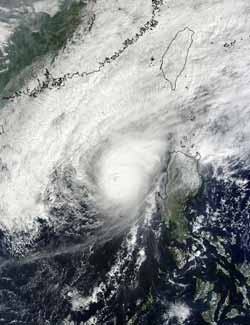NASA satellites see Typhoon Bopha fizzle over weekend

The MODIS instrument aboard NASA's Terra satellite captured this image of Bopha on Dec. 8 at 02:45 UTC (Dec. 7 at 9:45 p.m. EST/US) after it had regained typhoon status and was headed toward Luzon, Philippines.<br><br>Credit: NASA Goddard MODIS Rapid Response Team<br>
NASA's Aqua satellite has been providing data on Bopha since the day it formed on Nov. 26. In the storm's last days, Aqua's Atmospheric Infrared Sounder (AIRS) instrument captured infrared data of the storm and showed that cloud top temperatures warmed from Dec. 8 through Dec. 9 as cloud heights fell and thunderstorms lost their punch.
AIRS infrared data reveals where the coldest, highest cloud tops are located in a tropical cyclone. The coldest cloud tops indicate the strongest storms with the heaviest rain. On Dec. 8, AIRS data revealed a large area of strong thunderstorms surrounded the center of circulation as the storm skirted the west coast of Luzon, the northern Philippines. That same day, Bopha triggered more warnings for the Philippines.
Just one day before, Typhoon Bopha's maximum sustained winds were up to 110 knots (126 mph/203.7 kph), but increased wind shear started taking a toll on the storm. As Bopha moved closer to Luzon (northern Philippines), warnings were posted on Dec. 8. Public storm warning signal #2 was in effect in the Luzon provinces of Ilocos Norte & Sur and La Union; and Public storm warning signal #1 was in effect in the Luzon provinces of Cagayan, Calayan group of islands, Babuyan group of islands, Batanes group of islands, Abra, Apayao, Kalinga, Mt. Province, Benguet, Pangasinan. At 2100 UTC (4 p.m. EST/U.S.), Bopha's maximum sustained winds were near 45 knots (51.7 mph/83.3 kph), so it was still a tropical storm. Overnight on Dec. 8 into Dec. 9, wind shear increased and Bopha weakened into a tropical depression.
By Dec. 9 at 0300 UTC (Dec. 8 at 10 p.m. EST/U.S.) the Joint Typhoon Warning Center issued its final advisory on Bopha. At that time it was a tropical depression located near 18.3 north latitude and 119.2 east longitude, about 240 miles north-northwest of Manila, Philippines. The depression was moving slowly at 3 knots (3.4 mph/5.5 kph) to the northeast and dissipating under adverse atmospheric conditions just west of Luzon.
On Dec. 9, AIRS data showed quite a different picture as the strongest thunderstorms no longer surrounded the center of circulation and were blown away from the center because of wind shear. The area of strong thunderstorms had also diminished greatly, indicating a weakening storm. Wind shear had taken its toll on this once deadly storm and had blown it apart.
Media Contact
More Information:
http://www.nasa.govAll latest news from the category: Earth Sciences
Earth Sciences (also referred to as Geosciences), which deals with basic issues surrounding our planet, plays a vital role in the area of energy and raw materials supply.
Earth Sciences comprises subjects such as geology, geography, geological informatics, paleontology, mineralogy, petrography, crystallography, geophysics, geodesy, glaciology, cartography, photogrammetry, meteorology and seismology, early-warning systems, earthquake research and polar research.
Newest articles

After 25 years, researchers uncover genetic cause of rare neurological disease
Some families call it a trial of faith. Others just call it a curse. The progressive neurological disease known as spinocerebellar ataxia 4 (SCA4) is a rare condition, but its…

Lower dose of mpox vaccine is safe
… and generates six-week antibody response equivalent to standard regimen. Study highlights need for defined markers of mpox immunity to inform public health use. A dose-sparing intradermal mpox vaccination regimen…

Efficient, sustainable and cost-effective hybrid energy storage system for modern power grids
EU project HyFlow: Over three years of research, the consortium of the EU project HyFlow has successfully developed a highly efficient, sustainable, and cost-effective hybrid energy storage system (HESS) that…





















